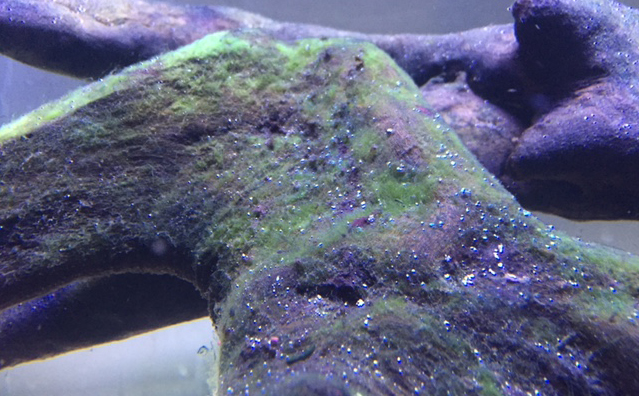 Everyone owning an aquarium or pond will have at one stage or another, run into algae problems. Whether these problems are on a small or large scale, you will inevitably have to work out the best way to combat any algae problem that arises in your own aquarium. Algae is always in the aquarium to some degree and most algae is harmless to fish and plants in small doses. It is only when overgrowth is seen that this signifies an imbalance of the eco-system.
Everyone owning an aquarium or pond will have at one stage or another, run into algae problems. Whether these problems are on a small or large scale, you will inevitably have to work out the best way to combat any algae problem that arises in your own aquarium. Algae is always in the aquarium to some degree and most algae is harmless to fish and plants in small doses. It is only when overgrowth is seen that this signifies an imbalance of the eco-system.
What is Algae?
Algae is a primitive form of plant life needing the same elements of light, nutrients and water, like aquatic plants to survive – which is why they are so prevalent in aquariums. Some algae are single cells while others can form larger, more complex colonies all the way up to that of seaweed. Algae differs from plants as it does not have the structured systems like stems, roots and leaves to carry out different actions. Diatoms are also a group of algae, being the most common type of Phytoplankton. There are over 25,000 types of algae with several more being classified to fit into this species.
Below are some of the more common ones found in an aquarium.
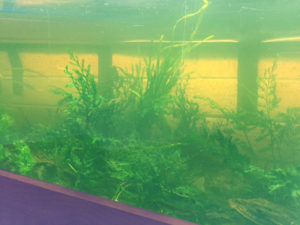 Green Water – Phytoplankton
Green Water – Phytoplankton
Can also be called an algae bloom. Caused by microscopic one celled algae that will appear to float in the aquarium, reducing visibility. Usually caused by a tank, high with nutrients and strong lighting. Can be seen in new aquariums and established aquariums. An algae bloom usually indicates a problem in the aquarium or pond due to the quality of the water. This can be due to various reasons. Repeated water changes helps to remove this. In worst cases the aquarium needs to be covered in black plastic for up to 3 days. In ponds, nutrient run off from the garden can also cause algae blooms.
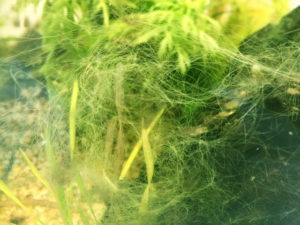 Filamentous algae
Filamentous algae
Forms long green threads that clump together creating on over growth commonly seen in aquariums and ponds. This algae is harder to remove as it entangles itself around plants and decorations. Not as commonly liked by algae eating fish and shrimp. Caused by too much light. Remove by hand or use an algaecide.
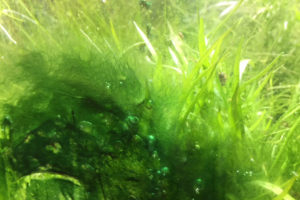 Blue-Green Algae
Blue-Green Algae
This is not an actual algae, it is a micro-organism called cyanobacteria. It will grow rapidly killing any plants it covers for too long. Easy to remove at first as it will slide off anything it touches. If left on plant leaves for too long remnants of it will remain. Poor water quality from excessive nitrates and phosphates are usually the cause. More water changes are needed. Reduce lighting.
Brown Algae
Caused by various diatoms, this algae is common in new tanks and forms a layer of film over ornaments and glass. Can be removed by wiping. It will eventually disappear once the tank becomes more established and when other competing algae out grow it. Occurs in tanks with dim lighting.
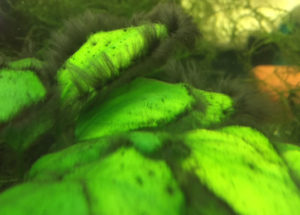 Red Algae
Red Algae
Beard Algae, Brush Algae. Its soft bristles give it a hairy look resembling that of a brush. Grows on anything it can attach itself to, attaching very strongly, making it difficult to remove. Mainly eaten by the Siamese Algae Eater. Also scrubbing with a firm brush will help to remove it. Dim lighting promotes diatoms and red algae.
 Green Spot Algae
Green Spot Algae
Common in an aquarium and quite harmless. It will grow over anything stationary. Slow growing plants, rocks, glass, driftwood and substrate if undisturbed. Will be eaten by algae eaters. Water changes help. Reduce lighting.
Algae can be controlled in a number of ways
Light
Never place a tank in direct sunlight or anywhere light will brightly reflect on a tank. Excessive light from sunlight or artificial light will cause increased algae growth. This is sure way for algae to multiply rapidly turning your water green. Even through blinds or curtains, a sliver of sunlight each day will be enough for this algae to appear.
Every tank has different lighting with brighter more intense lights needing less time to be on than others. Try reducing lighting time by ½ hour to 1 hour per day. More maybe needed. Once the problem has ceased then increase by 15 minute intervals to reach the desired level to maintain a tank with little algae. This allows not only extra viewing hours in the day but more time for plants, if you have them, to photosynthesis.
Provide a constant supply of light. Put a timer on the tank so the plants and fish are receiving the same amount of light each day. This will help as manually doing this can lead to extended periods of the light on a tank, which in turn, will increase algae.
Replace old bulbs after about 12 months as this can lead to algae growth. As the light intensity weakens it can pave way to a build up of algae. Thriving plants help to combat algae, with certain algae types growing with less intense lighting.
Plants
Plants will absorb nutrients from the aquarium. Bunch plants are the fastest absorber of nutrients. When plants are growing to their maximum potential, algae will be kept to a minimum. This means providing them with enough fertilizer so they can absorb more nutrients , giving off more oxygen.
Plants not only absorb excess nutrients from the water, they also provide shade. This reduces the amount of light on the aquarium which will help in your battle against algae. In ponds, shaded areas are very beneficial because they mainly receive direct sunlight. If there are no over-hanging trees to block out some of the sun, the use of lilies scattered throughout will help immensely.
A tank with a minimum plant setup should be dosed only the amount of fertilizer they need. Usually less than the recommended dose on a bottle. This will ensure no unused nutrients will be absorbed by algae, turning your water green.
On tanks with CO2, make sure there is enough flow and a constant supply of CO2 keeping levels up to so plants can absorb and grow to their maximum potential.
Just to note: Algae growth on plant leaves prevents the plant from receiving light, which in turn stops the gas exchange – from carbon dioxide to oxygen, plus the absorption of nutrients through their leaves.
Water
Most people don’t keep enough test kits on hand making it difficult to see what is going on with their aquarium water. A water change is the most effective way to remove any excess toxins and algae from the aquarium. Several water changes over a period of 1-2 weeks may need to be done in order to bring an algae problem under control, especially green water. Algae likes warmer water so try to avoid a tank with higher temperatures. Temperatures above 26 degrees allows algae growth to accelerate, so extra care is needed in a warmer tank.
Algae loves phosphates. For tanks with high phosphates or tap water with higher than normal phosphates, putting a phosphate remover in the filter will help to keep these levels down, thus controlling algae.
Running all water past a UV light will help to control green water. UV irradiation kills algae cells as it passes sending cleaner, clearer water back into the aquarium. Barley straw extract helps to suppress green water growth naturally by binding to the algae before it grows. Algaecide on the other hand will control green water and filamentous algae by disrupting the photosynthesis process over a period of days. Always follow dosage amounts as excess may do more harm than good to fish and plants. Best to use as a last resort.
You will find algae blooms can suddenly die off when there is no more nutrients for them to consume. Whether it is from a natural occurrence or from an algaecide, large amounts of dead algae can be dangerous to a tank or pond as they can have an effect on the quality of water. Try and remove as much of this dead algae as possible to maintain a healthy environment for your fish.
Aeration
Algae will reduce the dissolved oxygen in the aquarium thus killing off essential nitrifying bacteria. This bacteria helps to keep an aquarium clean. The addition of an air pump or filter will help to combat algae as the increase of aeration in the tank will help the biological cycle of the tank, keeping the water cleaner.
Fish
Algae eaters love an abundant source of algae to graze on, which helps in the reduction of algae in an aquarium. Keeping a range of algae eating fish, snails and shrimp, helps to combat the different types of algae. The more the better to keep down the threat of an algae outbreak. Some examples are, Siamese Algae Eaters, Bristlenose Catfish, Plecostomus, Otocinclus Catfish, Cherry Shrimp, Yamato Shrimp & American Flag Fish. Snails can help with eating algae but careful attention is needed as snail populations can quickly grow. Over feeding is one of the largest factors contributing to algae growth. Reduce feeding so there is no remnants of food left in the tank after meals.
Manually
Remove most of the algae by hand or a siphoning tube. Use a magnetic scraper to remove algae from the glass. When using a magnetic scraper, be careful not to get any substrate caught between the glass and the scraper as this will leave scratch marks on the glass. In hard to reach spots the use of an old toothbrush will make this eaiser. For algae that is even more resilient, use a razor blade to make the job far less time consuming. Be careful to not scrap at an angle as this can scratch the glass.
Decorations can be removed and scrubbed down so they are free from algae. Also plant leaves on slow growing plants like Anubias can be brushed down gently to remove excess algae.
Hydrogen peroxide or a bleach solution can be used to clean decorations. Bleach can be quite strong so washing thoroughly after cleaning is needed to make sure all is removed. Hydrogen peroxide is more water based as is very easily diluted by the addition of extra water. A better choice for cleaning.
